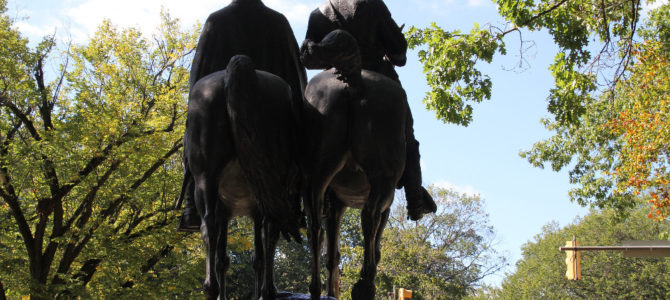
Not to be caught napping while statues were toppling, the College Art Association (CAA) issued a late August query to member academics: “Taking Down Public Art —What do Art Historians and Scholars Think?” What is to be done with controversial works of public art? Should they be removed? Should they be destroyed? Does it even matter?
As used here, the word controversial applies first to Confederate memorials but extends to all works that offend social justice sensibilities or unnerve particular identity groups. Historical figures from Christopher Columbus and Robert E. Lee to Peter Stuyvesant and Stonewall Jackson are in the dock. If the judgments and designs of previous generations are outmoded, no longer admissible, their monuments fall into disrepute. If the past does not accommodate the present, well then . . . off with its head?
CAA’s September 13 newsletter carried poll results following a lead editorial decrying efforts to rescind President Obama’s Deferred Action for Child Arrivals executive order—itself a clue to the drift of academics’ opinion. To insure that returns were noticed, CAA repeated the results on the 20th.
Forty-five responses were posted. (With some 13,000 members, CAA’s sampling is tiny. Whether the tenor of selected responses accurately represents the membership or reflects the director’s bent, it is impossible to know.) The overwhelming majority—37—were by women. A mere five signatories were identifiably male. Of these, four signed their names in full. Richard Saunders, director of Middlebury College Art Museum, skipped opinion for an opportunity to pump his timely and pressing book on the subject of public art. Three respondents chose anonymity.
Keep the Art, Just Hide It
The feedback is an inventory of throat-clearings, all straining to split the difference between outright iconoclasm and cautious accommodation to the politics of memory. On one hand, offensive monuments should not be destroyed. At the same time, they must not remain in place. How to balance dueling demands? Move the stuff. Re-contextualize is the going mantra. Displacement allows academics to retain historical artifacts—an art historian’s raison d’etre—while keeping their place in the faculty room hymnal.
The bulk of responses echo the pseudonymous New York City art historian:
Destroying these works is destroying part of our nation’s artistic heritage. Still, because of the ideology that the sculptures represent, I believe they should not be out in public squares. They should be moved to local art museums, history museums, or park preserves that can do a better job of contextualizing them for visitors. Public places should be maintained for monuments that speak to the entire community, not just a small segment of it.
Eva (no surname) agrees:
They should be removed, and ideally placed in a separate park or museum designed to PROPERLY contextualize them. That means an unflinching look both at the cruelty of the institutions these figures supported, AND at the actual circumstances in which the statues were raised (and their intended impact on people of color).
The word contextualize accompanies predictable expectation that art historians are indispensable for giving the public proper “contextual didactic information.” Each offending object should be reviewed by a committee of art historians backed by general historians, public design commissions, or “informed spokespeople.” What constitutes an informed spokesperson? And on whose behalf would this authority speak, the long dead or today’s aggrieved? Maylen offers a clue to where that trolley might head:
I believe public works of art that inspire negativity or harmful attitudes, should be removed. The fact that confederate monuments are still standing today promotes the idea that it is okay to support the antiquated and prejudiced views of these historical figures. If these monuments promote views that exclude systematically oppressed groups, then they should be taken down. . . . there is a difference.
Maylen, in sync with her [I’m guessing] colleagues, has greater command of reigning buzzwords than of historical analysis. Can a serious scholar believe that Confederate monuments, elegiac in intention, endorsed racial despotism and promote it today? Only minds marinated too long in the conditioning mechanisms of academia can see in a statue of Robert E. Lee or a Confederate soldier—emblem of someone’s son, spouse, brother, or father—approval of slavery or support for a return to attitudes and practices of the pre-bellum South.
Your Charity Is Actually Pernicious
Stay for a moment with Lee’s statue in Charlottesville. True, it was erected in the Jim Crow era. But that is hardly the sum of it. It had been commissioned in 1917 by Paul Goodloe McIntire, a broker on the Chicago and New York Stock Exchange and a philanthropist. His generosity to the University of Virginia is legendary. The Charlottesville monument was a gift to the city of his birth.
McIntire was a man who gave gifts. In 1927, France inducted him into its Legion of Honor in recognition of a children’s tuberculosis hospital he founded in France for refugees from the German-occupied north. Yet among CAA’s complainants, every Confederate remembrance in stone or bronze was the doing of blue-eyed devils.
Equating memorial intention with the moral squalor and cruelty of Jim Crow distorts the past and misleads the present. Bethanie Rayburn described all monuments as “an expression of WASP hegemony during the Jim Crow era.” She forgets that white Anglo-Saxon Protestants were the backbone of the anti-slavery Republican Party. Jim Crow was the ugly creation of Southern Democrats—not usually described as WASPs.
Adapting the principle that bad speech should be countered with good speech, a Berlin-based academic suggests adding “a second monument to explain the context” of the first. Anonymous recommends putting them in cold storage so they cannot become pilgrimage sites. A San Francisco professor of animation argues for confining Confederate statues to some cordoned-off precinct where impressionable people will not see them. Her proposal mimics an old argument about pornography: Only an educated elite has the capacity to view it without being corrupted by it:
Students do not need to be reminded of dark history in their daily living environment. Public works of art that promote racism, sexism, agism [sic], homophobia, etc., should be removed. Hate crimes are too prevalent today; monuments that are complicit in hate of any kind are not the values we should promote with public art.
This Is Really a Power Play
Toying with martyrdom, white women queue up at the podium to play the skin game. Listen to Renee McGarry, Sotheby’s own virtue signaler:
Many art historians see important statues while people of color see perpetrators of continuing oppression and white supremacy. . . . [This] demonstrates the overwhelming whiteness of a field that has allowed itself to be complicit in the continuing oppression of Black people. . . . It depresses me how many art historians and other academics want to act as if the monuments [do not exist] in the context of mass incarceration, violent policing, voter suppression, and generalized, violent discrimination that Black people face on a daily basis.
Jessica Santone delivers a multi-paragraph manifesto against “generic symbols of collective hate” and all cultural objects “commemorating colonization, subjugation, and the violence of oppressors”:
They might wear the white costumes of a Beaux-Arts aesthetic, but these statues form a perpetual and stationary KKK march through our public lands. . . .
It is IMPERATIVE that we all listen when people of color say they are harmed by the presence of these objects in public spaces. . . . Not listening to people of color is how white people perpetuate white supremacy. . . . Those of us who wish to disavow white supremacy must TAKE ACTION to stop it. We must follow POC-led [people of color] in THEIR proposed solutions for dismantling white supremacy.
Does it matter to art historians that the KKK was the military wing of the Southern Democrats? Perhaps they do not know.
Jaune Quick-to-See, a contemporary Native American artist, lets slip the animus that fuels our sudden monument mania. Note her closing phrase:
These statues . . . are the works of an oppressive government that insisted on telling their hegemonic version of history. There is a possibility of having some input from our diverse population and we need to respect all our races, not just the European — especially since the white population is going to be a minority soon.
Only two respondents—both male—bucked the tide of racial polemics. Richard Woodfield, an esteemed Gombrich scholar, was terse: “I immediately think of the actions of the Taliban in Afghanistan and ISIS in Syria. Were their actions justified?” James Langley, a painter on faculty at Savannah College of Art and Design, was more explicit. He condemned violence against civic memory as vandalism and censorship:
[It is] perpetrated by hysterical mobs who display the very fascistic mentality they claim to oppose. This type of violence is a form of public terror without any due process or rational discussion and is also typical of radical Islam that seeks to obliterate everything that opposes its narrow ideology. Conflating every vestige and symbol of the Confederate States with an endorsement of slavery is idiotic and historically inaccurate.
Despite pervasive emphasis on contextualizing, the run of CAA responses gives no hint of substantial historical knowledge beyond the received tropes of popular culture and press. Identity politics trumps the cumbersome realities of history. The sentimentality of our intelligentsia tilts toward deference to Ta-Nehisi Coates and his insidious pensées on whiteness. Not a single respondent indicates familiarity with either of the two towering historians of slavery and race relations in this country: C. Vann Woodward and Eugene Genovese.
Among bedrock necessities are Woodward’s “The Strange Career of Jim Crow” and “Origins of The New South: 1877-1913,” plus Genovese’s magisterial “Roll, Jordan, Roll.” Shelby Foote’s Civil War narratives belong on the shelf with them. Foote reminded us that it took time after Appomattox for raw anguish to subside before the hard work of closing wounds could take place between North and South. Erecting Confederate monuments was forbidden before the Compromise of 1877, which ended Reconstruction.
To use timing to stigmatize Confederate monuments as products of Jim Crow is a slur against a painful, stumbling effort at national reconciliation. It is an affront to history.
But Coates’ epistles to his son on the jeopardy of being black in contemporary America is an easier read for academics posturing on imagined ramparts.









